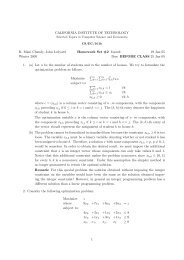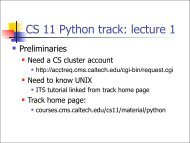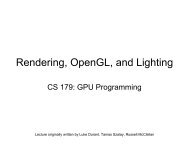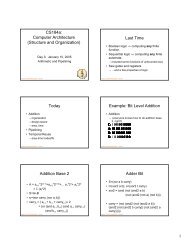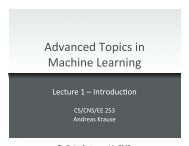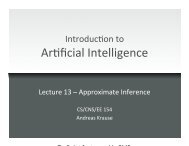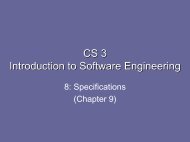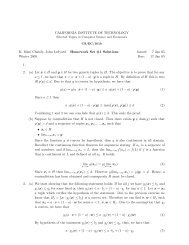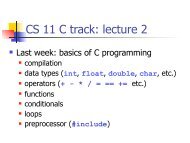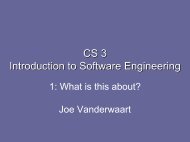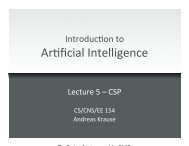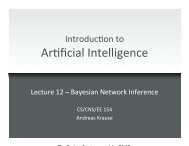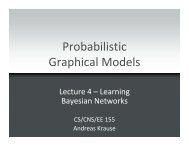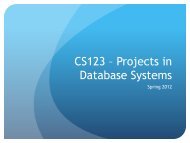1 Differential Forms - Caltech
1 Differential Forms - Caltech
1 Differential Forms - Caltech
You also want an ePaper? Increase the reach of your titles
YUMPU automatically turns print PDFs into web optimized ePapers that Google loves.
Recall that the 1-form ω used in discretize oneform is given by<br />
ω(x, y) = 2e −(x2 +y 2) ((x + y)dx + (y − x)dy) ,<br />
which is depicted at the beginning of this section 6 . The Hodge decomposition of ω can be expressed analytically<br />
as<br />
ω(x, y) = ∇g(x, y) + ∇ × g(x, y)<br />
where g = α = β serves as both the scalar and the vector potential, and is given by<br />
g(x, y) = −e x2 +y 2 .<br />
Hence, the potentials α and β should both look like a Gaussian “bump,” and the curl-free and divergencefree<br />
components ∇α and ∇ × β of ω should look like the source and vortex pictured at the beginning of this<br />
section.<br />
When debugging, you may find it useful to discretize ∇α and ∇ × β directly and compare with the 1-forms<br />
computed via Hodge decomposition. (At the very least, you should verify that your output files roughly match<br />
the appearance of the images above.) Additionally, three alternative definitions for omega are provided to help<br />
verify the correctness of your routines: a purely curl-free omega, a purely divergence-free omega, and a purely<br />
harmonic omega. For each of these cases Hodge decomposition should reproduce the input exactly in one of<br />
the three components (curlfree, divfree, or harmonic) while the other two components should vanish.<br />
(Simply uncomment the appropriate line to use one of these test cases.) Additionally, two meshes are provided<br />
for testing: disk.obj and annulus.obj. The harmonic part of the output should always be zero for the disk,<br />
and you should find a non-zero harmonic part for 1-forms over the annulus.<br />
stderr = 2;<br />
input_filename = ’../meshes/disk.obj’;<br />
fprintf( stderr, ’Reading...\n’ );<br />
[V,E,F] = read_mesh( input_filename );<br />
fprintf( stderr, ’Building exterior derivatives...\n’ );<br />
[d0,d1] = build_exterior_derivatives( V, E, F );<br />
fprintf( stderr, ’Computing circumcenters...\n’ );<br />
[c0,c1,c2] = compute_circumcenters( V, d0, d1 );<br />
fprintf( stderr, ’Writing circumcentric subdivision...\n’ );<br />
write_circumcentric_subdivision( ’subdivision.ps’, d0, d1, c0, c1, c2 );<br />
fprintf( stderr, ’Building Hodge stars...\n’ );<br />
[star0,star1,star2] = build_hodge_stars( d0, d1, c0, c1, c2 );<br />
fprintf( stderr, ’Discretizing smooth 1-form...\n’ );<br />
omega = discretize_oneform( V, E );<br />
% Some test cases:<br />
% omega = d0*rand(size(V,2),1); % curl-free test case<br />
% omega = (star1ˆ-1)*d1’*star2*rand(size(F,1),1); % divergence-free test case<br />
% omega = null( d0*(star0ˆ-1)*d0’*star1 + (star1ˆ-1)*d1’*star2*d1 ); % harmonic test case<br />
fprintf( stderr, ’Decomposing discrete 1-form...\n’ );<br />
[ curlfree, divfree, harmonic ] = decompose_oneform( omega, d0, d1, star0, star1, star2 );<br />
M = max( abs( omega ));<br />
6 Note that this 1-form does not have compact support, which was one of the requirements of the Hodge decomposition theorem!<br />
Numerically, however, the field decays fast enough that we can treat it as compact – in general certain boundary conditions are required<br />
to deal with non-compactness. For more details, see Tong et al, Discrete Multiscale Vector Field Decomposition, in the Proceedings of ACM<br />
SIGGRAPH 2003.<br />
14



